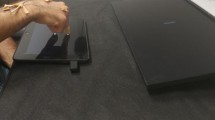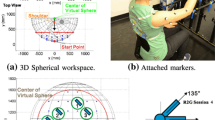Abstract
It has been found in our previous studies that the initiation of aperture closure during reach-to-grasp movements occurs when the hand distance to target crosses a threshold that is a function of peak aperture amplitude, hand velocity, and hand acceleration. Thus, a stable relationship between those four movement parameters is observed at the moment of aperture closure initiation. Based on the concept of optimal control of movements (Naslin 1969) and its application for reach-to-grasp movement regulation (Hoff and Arbib 1993), it was hypothesized that the mathematical equation expressing that relationship can be generalized to describe coordination between hand transport and finger aperture during the entire reach-to-grasp movement by adding aperture velocity and acceleration to the above four movement parameters. The present study examines whether this hypothesis is supported by the data obtained in experiments in which young adults performed reach-to-grasp movements in eight combinations of two reach-amplitude conditions and four movement-speed conditions. It was found that linear approximation of the mathematical model described the relationship among the six movement parameters for the entire aperture-closure phase with very high precision for each condition, thus supporting the hypothesis for that phase. Testing whether one mathematical model could approximate the data across all the experimental conditions revealed that it was possible to achieve the same high level of data-fitting precision only by including in the model two additional, condition-encoding parameters and using a nonlinear, artificial neural network-based approximator with two hidden layers comprising three and two neurons, respectively. This result indicates that transport-aperture coordination, as a specific relationship between the parameters of hand transport and finger aperture, significantly depends on the condition-encoding variables. The data from the aperture-opening phase also fit a linear model, whose coefficients were substantially different from those identified for the aperture-closure phase. This result supports the above hypothesis for the aperture-opening phase, and consequently, for the entire reach-to-grasp movement. However, the fitting precision was considerably lower than that for the aperture-closure phase, indicating significant trial-to-trial variability of transport-aperture coordination during the aperture-opening phase. Implications for understanding the neural mechanisms employed by the CNS for controlling reach-to-grasp movements and utilization of the mathematical model of transport-aperture coordination for data analysis are discussed.





Similar content being viewed by others
Notes
The least complex approximator is the one with the smallest number of coefficients requiring optimization to fit the data. The simplest possible approximator is a linear function, where the optimization of the coefficients is made through linear regression. It corresponds to an artificial neural network consisting of only one neuron that computes a weighed sum of the inputs.
To someone who is used to thinking about motor control in terms of kinematic parameters as continuous sequences of values within a specific time interval, it might seem that, since, for instance, acceleration as a function of time can be computed as a time derivative of velocity, it must be sufficient to include only one such parameter in equations. In the case of the equation describing transport-aperture coordination, however, instantaneous values of such parameters are involved, and therefore, a different logic applies. Knowledge of hand velocity at a certain time point t in general does not allow one to calculate hand acceleration and vice versa. For this reason, these kinematic variables are viewed in theoretical mechanics as state coordinates independent of each other.
This was so apparently due to the fact that the number of patterns for ANN training was very large (10,000) compared to the number of unknown coefficients (i.e. synaptic weights), which was not greater than 35 for the set of ANN candidates. Therefore, the probability of overfitting was practically zero.
References
Alberts JL, Saling M, Stelmach GE (2002) Alterations in transport path differentially affect temporal and spatial movement parameters. Exp Brain Res 143:417–425
Ansuini C, Santello M, Tubaldi F, Massaccesi S, Castiello U (2007) Control of hand shaping in response to object shape perturbation. Exp Brain Res 180:85–96
Bootsma RJ, Van Wieringen PCW (1992) Spatio-temporal organization of natural prehension. Hum Mov Sci 11:205–215
Castiello U, Bennett K, Bonfiglioli C, Lim S, Peppard RF (1999) The reach-to-grasp movement in Parkinson’s disease: response to a simultaneous perturbation of object position and object size. Exp Brain Res 125:453–462
Castiello U, Bennett K, Chambers H (1998) Reach to grasp: the response to a simultaneous perturbation of object position and size. Exp Brain Res 120:31–40
Churchill A, Hopkins B, Rönnqvist L, Vogt S (2000) Vision of the hand and environmental context in human prehension. Exp Brain Res 134:81–89
Churchill A, Vogt S, Hopkins B (1999) The coordination of two-effector actions: spoon-feeding and intermanual prehension. Br J Psychol 90:271–90
Fitts PM (1954) The information capacity of the human motor system in controlling the amplitude of movement. J Exp Psychol 47:381–391
Gentilucci M, Castiello U, Corradini ML, Scarpa M, Umiltà C, Rizzolatti G (1991) Influence of different types of grasping on the transport component of prehension movements. Neuropsychologia 29:361–378
Gentilucci M, Chieffi S, Scarpa M, Castiello U (1992) Temporal coupling between transport and grasp components during prehension movements: effects of visual perturbation. Behav Brain Res 47:71–82
Haggard P, Wing AM (1997) On the hand transport component of prehensile movements. J Mot Behav 29:282–287
Haggard P, Wing AM (1991) Remote responses to perturbation in human prehension. Neurosci Lett 122:103–108
Haggard P, Wing AM (1995) Coordinated responses following mechanical perturbation of the arm during prehension. Exp Brain Res 102:483–494
Hoff B, Arbib MA (1993) Models of trajectory formation and temporal interaction of reach and grasp. J Mot Behav 25:175–192
Jeannerod M (1981) Intersegmental coordination during reaching at natural visual objects. In: Long J, Baddeley A (eds) Attention and performance IX. Erlbaum, Hillsdale, pp 153–168
Jeannerod M (1984) The timing of finger grip during prehension: a cortically mediated visuomotor pattern. J Mot Behav 16:235–254
Jeannerod M, Arbib MA, Rizzolatti G, Sakata H (1995) Grasping objects: the cortical mechanisms of visuomotor transformation. Trends Neurosci 18:314–320
Mason CR, Theverapperuma LS, Hendrix CM, Ebner TJ (2004) Monkey hand postural synergies during reach-to-grasp in the absence of vision of the hand and object. J Neurophysiol 91:2826–2837
Marteniuk GG, Leavitt JL, MacKenzie CL, Athenes S (1990) Functional relationships between grasp and transport components in a prehension task. Hum Mov Sci 9:149–176
Naslin P (1969) Essentials of optimal control. Boston Technical Publishers, Cambridge
Paulignan Y, MacKenzie C, Marteniuk R, Jeannerod M (1991) Selective perturbation of visual input during prehension movements: 1. The effects of changing object position. Exp Brain Res 83:502–512
Rand MK, Lemay M, Squire LM, Shimansky YP, Stelmach GE (2007a) Role of vision in aperture closures control during reach-to-grasp movements. Exp Brain Res 181:447–460
Rand MK, Shimansky Y, Hossain ABM, Stelmach GE (2007b) On-line variation of transport-aperture coordination precision during reach-to-grasp movements. Neurosci Abstr 33: Program #412.1
Rand MK, Shimansky Y, Stelmach GE, Bracha V, Bloedel JR (2000) Effects of accuracy constrains on reach-to-grasp movements in cerebellar patients. Exp Brain Res 135:179–188
Rand MK, Shimansky Y, Stelmach GE, Bloedel JR (2004) Adaptation of reach-to-grasp movement in response to force perturbations. Exp Brain Res 154:50–65
Rand MK, Smiley-Oyen AL, Shimansky YP, Bloedel JR, Stelmach GE (2006a) Control of aperture closure during reach-to-grasp movements in Parkinson’s disease. Exp Brain Res 168:131–142
Rand MK, Squire LM, Stelmach GE (2006b) Effect of speed manipulation on the control of aperture closure during reach-to-grasp movements. Exp Brain Res 174:74–85
Rand MK, Squire LM, Lemay M, Shimansky YP, Stelmach GE (2006c) Altering the presence of vision and trunk movement during reach-to-grasp movement in Parkinson’s disease. Mov Disord 21(Suppl 15):S502–S503
Rand MK, Stelmach GE (2005) Effect of orienting the finger opposition space in the control of reach-to-grasp movements. J Mot Behav 37:65–78
Saling M, Mescheriakov S, Molokanova E, Stelmach GE, Berger M (1996) Grip reorganization during wrist transport: the influence of an altered aperture. Exp Brain Res 108:493–500
Santello M, Soechting JF (1998) Gradual molding of the hand to object contours. J Neurophysiol 79:1307–1320
Schettino LF, Adamovich SV, Poizner H (2003) Effects of object shape and visual feedback on hand configuration during grasping. Exp Brain Res 151:158–166
Schmidt RA, Zelaznik HN, Hawkins B, Frank JS, Quinn JT (1979) Motor output variability: a theory for the accuracy of rapid motor acts. Psychol Rev 86:415–451
Smeets JBJ, Brenner E (1999) A new view on grasping. Motor Control 3:237–271
Theverapperuma LS, Hendrix CM, Mason CR, Ebner TJ (2006) Finger movements during reach-to-grasp in the monkey: amplitude scaling of a temporal synergy. Exp Brain Res 169:433–448
Timmann D, Stelmach GE, Bloedel JR (1996) Temporal control of the reach and grip components during a prehension task in humans. Neurosci Lett 207:133–136
Wallace SA, Weeks DL (1988) Temporal constraints in the control of prehensile movement. J Mot Behav 20:81–105
Wallace SA, Weeks DL, Kelso JAS (1990) Temporal constraints in reaching and grasping behavior. Hum Mov Sci 9:69–93
Wang J, Stelmach GE (1998) Coordination among the body segments during reach-to-grasp action involving the trunk. Exp Brain Res 123:346–350
Wang J, Stelmach GE (2001) Spatial and temporal control of trunk-assisted prehensile actions. Exp Brain Res 136:231–240
Watson MK, Jakobson LS (1997) Time to contract and the control of manual prehension. Exp Brain Res 117:273–280
Winges SA, Weber DJ, Santello M (2003) The role of vision on hand preshaping during reach to grasp. Exp Brain Res 152:489–498
Woodworth RS (1899) The accuracy of voluntary movement. Psychol Rev 3(Suppl 2):1–114
Zaal FTJM, Bootsma RJ, Van Wieringen PCW (1998) Coordination in prehension: information-based coupling of reaching and grasping. Exp Brain Res 119:427–435
Acknowlegments
This research was supported by grants from NINDS NS 39352 and 40266.
Author information
Authors and Affiliations
Corresponding author
Appendix
Appendix
Derivation of an equation describing coordination between hand transport and grasp aperture
Reach-to-grasp movements can be viewed as consisting of two independently and optimally controlled processes (hand transport and grasping), which are required to finish simultaneously. Note that their independence here is understood as the independence of the corresponding optimality criteria. Simple examples of such criteria are described, e.g., in Hoff and Arbib (1993). The final state for hand position and aperture is determined by the target’s location and size, respectively. A control action for regulating the transport and the aperture can be presented, e.g., as hand transport acceleration and as finger aperture acceleration, respectively (Hoff and Arbib 1993). Hence, an optimal control law for hand transport and grasp aperture can be described by the following set of equations
and
where D, V w, and A w are the instantaneous values of hand–target distance, wrist velocity, and wrist acceleration, respectively; G, V g, and A g are grip aperture and the corresponding velocity and acceleration, respectively; and T is the amount of time left to target contact. Note that the explicit inclusion of T in the above control laws does not imply that that parameter is prescribed. On the contrary, in this case, it is a variable requiring optimization (Naslin 1969). If two control processes are required to finish simultaneously, the optimization of movement time left to finish has to be performed according to a generalized optimality criterion that can be expressed, e.g., as a weighted sum of such criteria corresponding to the control of hand transport and grip aperture if optimized separately from each other. By excluding T from the above equation set (Eqs. 10, 11), one obtains an equation describing a functional relationship between all other movement parameters:
This equation is rather general because it does not depend on the results of optimizing T. By solving Eq. 12 with respect to D, one obtains
It should be emphasized that the existence of Eq. 13 is based on an assumption that both the hand transport and grasp aperture are regulated optimally. Therefore, the precision with which any related experimental data can be approximated based on that equation strongly depends on how close to optimality are the control actions regulating the above two processes.
Rights and permissions
About this article
Cite this article
Rand, M.K., Shimansky, Y.P., Hossain, A.B.M.I. et al. Quantitative model of transport-aperture coordination during reach-to-grasp movements. Exp Brain Res 188, 263–274 (2008). https://doi.org/10.1007/s00221-008-1361-5
Received:
Accepted:
Published:
Issue Date:
DOI: https://doi.org/10.1007/s00221-008-1361-5




